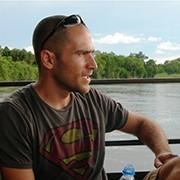Omri Bronstein is a senior lecturer at the School of Zoology since 2019. He was trained as an undergraduate student at the Faculty of Life Sciences, Tel-Aviv University (2003-2006). He then proceeded to complete his M.Sc. (2006-2009) and Ph.D. (2009-2014) at Tel-Aviv University, studying the ecology, biology, reproduction and evolutionary history of echinoderms. During a post-doc position at The Steinhardt Museum of Natural History he engaged in an EU sponsored project at the Natural History Museum in Vienna (NHMW), Austria, a collaboration that facilitated his integration as a post-doc fellow at the same institution. During his time at the NHMW, Omri expanded his interest to other marine taxa such as corals, annelids, tunicates, and crustaceans. His research questions and interest are mostly addressed with an interdisciplinary approach integrating molecular genetics (from single genes to genomes), taxonomy (from extant to fossil taxa), ecology, and the reproductive traits of the organisms he studies.
Prof. Omri Bronstein

Biography
CV
Research Interests
Understanding the forces that drive speciation in marine environments is challenging. High dispersal potential of organisms with planktonic larvae and lack of clear geographic barriers to gene flow, greatly complicate our ability to reconstruct the chain of events leading to the formation of new species. Consequently, Omri employs a multi-disciplinary approach, integrating novel genomic tools with state-of-the-art comparative morphology to answer questions pertaining the ecology, biogeography, phylogeny and evolution of benthic marine taxa. He often utilizes genetic tools to answer questions pertaining to the presence of cryptic alien species, assert phylogenetic and biogeographic relationships, and model species distributions based on genetic information.
Sexual reproduction, the primary process for generating new genetic lineages, is fundamental to our understanding of biodiversity, biogeography and evolution at large. Yet, as global warming and climate-change proceeds ever more rapidly, organisms depending on seasonal cues to synchronize their reproduction, face an unclear future. Hence Omri is particularly interested in studying sexual reproduction of broadcast spawning marine invertebrates, from the environmental regulation of gametogenesis and spawning, through fertilization dynamics and hybridization, to gamete incompatibility and reproductive barriers.
Echinoderms as model organisms
Echinoderms comprise one of the most prominent and wide-spread groups of benthic marine invertebrates. Distributed across all of the world's oceans, from the poles to the equator and from the abyssal to intertidal depths, they are among the most ecologically significant components of diverse marine environments. Comprising roughly 7000 living species, echinoderms are the second-largest group of deuterostomes, strategically situated at the base of the evolutionary split leading to vertebrates. This unique evolutionary setup coupled with their fundamental ecological role, turns echinoderms into a primary research model taxon.
Publications
Bronstein O., Kroh A. (2019). The first mitochondrial genome of the model echinoid Lytechinus variegatus and insights on odontophoran phylogenomics. Genomics, 111(4): 710-718. DOI 10.1016/j.ygeno.2018.04.008
Eyal-Shaham L., Eyal G., Harii S., Kazuhiko S., Sinniger F., Bronstein O., Ben-Zvi O., Shlesinger T., Loya Y. (2019). Repetitive sex change in the stony coral Herpolitha limax across a wide geographic range. Scientific Reports, 9(1): 2936. DOI 10.1038/s41598-018-37619-y
Bronstein O., Kroh A., Miskelly A.D., Smith S.D.A, Dworjanyn S.A., Mos B., Byrne M. (2019). Implications of range overlap in the commercially important sea urchin genus Tripneustes. Marine Biology, 166:34. DOI 10.1007/s00227-019-3478-4
Bronstein O., Kroh A. (2018). Needle in a haystack – genetic evidence confirms the expansion of the invasive echinoid Diadema setosum to Israel waters. Zootaxa, 4497:4. DOI 10.11646/zootaxa.4497.4.9
Bronstein O., Kroh A., Haring E. (2018). Mind the gap! The mitochondrial control region and its power as a phylogenetic marker. BMC Evolutionary Biology, 18:80. DOI 10.1186/s12862-018-1198-x
Kroh A., Bronstein O., Coppard S. (2018). Stenonaster Lambert, 1922 (Echinodermata, Echinoidea, Stenonasteridae): proposed conservation by reversal of precedence Stenocorys Lambert, 1917. The Bulletin of Zoological Nomenclature 75(1):55-58. DOI 10.21805/bzn.v75.a013
Perry O., Bronstein O., Blecher N., Atkins A., Kupriyanova E., ten Hove H., Levi O., Fine M. (2018). On the genus Spirobranchus (Annelida, Polychaeta, Serpulidae) from the northern Red Sea, and a description of a new species. Invertebrate Systematics, 32:605-626. DOI 10.1071/IS17061
Bronstein O., Georgopoulou E., Kroh A. (2017). On the distribution of the invasive long-spined echinoid Diadema setosum and its expansion in the Mediterranean Sea. Marine Ecology Progress Series, 583:163-178. DOI 10.3354/meps12348
Bronstein O., Kroh A., Tautscher B., Liggins L., Haring E. (2017). Cryptic speciation in pan-tropical sea urchins: a case study of an edge-of-range population of Tripneustes from the Kermadec Islands. Scientific Reports, 7: 5948. DOI 10.1038/s41598-017-06183-2
Bronstein O., Kroh A., Haring E. (2016). Do genes lie? Mitochondrial capture masks the Red Sea collector urchin's true identity (Echinodermata: Echinoidea: Tripneustes gratilla). Molecular Phylogenetics and Evolution, 104: 1-13. DOI 10.1016/j.ympev.2016.07.028
Bronstein O., Kroh A., Loya Y. (2016). Reproduction of the long-spined sea urchin Diadema setosum in the Gulf of Aqaba - implications for the use of gonad-indexes. Scientific Reports, 6: 29569. DOI 10.1038/srep29569
Gewing M.-T., Bronstein O., Nagar L.R., Granot I., Frid O., Shenkar N. (2016). First record of the non-indigenous ascidian Microcosmus exasperatus, Heller 1878, in Cyprus. Marine Biodiversity, 1-5. DOI 10.1007/s12526-015-0442-5
Downs C.A., Kramarsky-Winter E., Segal R., Fauth J., Knutson S., Bronstein O., Ciner F.R., Jeger R., Lichtenfeld Y., Woodley C.M., Pennington P., Cadenas K., Kushmaro A., Loya Y. (2016). Toxicopathological effects of the sunscreen UV filter, oxybenzone (benzophenone-3), on coral planulae and cultured primary cells and its environmental contamination in Hawaii and the U.S. Virgin Islands. Archives of Environmental Contamination and Toxicology, 70(2): 265-288. DOI 10.1007/s00244-015-0227-7
Shlesinger T., Bronstein O., Loya Y. (2016). Spawning behavior of the sand dollar Sculpsitechinus auritus (Leske, 1778). Coral Reefs, 35(1), 327. DOI 10.1007/s00338-016-1399-y
Bronstein O., Loya Y. (2015). Photoperiod, temperature, and food availability as drivers of the annual reproductive cycle of the sea urchin Echinometra sp. from the Gulf of Aqaba (Red Sea). Coral Reefs 34: 275-289. DOI 10.1007/s00338-014-1209-3
Bronstein O., Loya Y. (2014). Echinoid community structure and rates of herbivory and bioerosion on exposed and sheltered reefs. Journal of Experimental Marine Biology and Ecology 456: 8-17. DOI 10.1016/j.jembe.2014.03.003
Downs C.A., Kramarsky-Winter E., Fauth J., Segal R., Bronstein O., Jeger R., Lichtenfeld Y., Woodley C., Pennington P., Kushmaro A., Loya Y. (2014). Toxicological effects of the sunscreen UV filter, benzophenone-2, on planulae and in vitro cells of the coral, Stylophora pistillata. Ecotoxicology 23(2): 175-191. DOI 10.1007/s10646-013-1161-y
Bronstein O., Loya Y. (2013). The taxonomy and phylogeny of Echinometra (Camarodonta: Echinometridae) from the Red Sea and Western Indian Ocean. PLoS ONE 8(10): e77374. DOI 10.1371/journal.pone.0077374
Bronstein O., Loya Y. (2011). Daytime spawning of Porites rus on the coral reefs of Chumbe Island in Zanzibar, Western Indian Ocean (WIO). Coral Reefs 30: 441-441. DOI 10.1007/s00338-011-0733-7
Alamaru A., Bronstein O., Dishon G., Loya Y. (2009). Opportunistic feeding by the fungiid coral Fungia scruposa on the moon jellyfish Aurelia aurita. Coral Reefs 28: 865-865. DOI 10.1007/s00338-009-0507-7
Shenkar N., Bronstein O., Loya Y. (2008). Population dynamics of a coral reef ascidian in a deteriorating environment. Marine ecology progress series 367: 163-171. DOI 10.3354/meps07579


